世界各国的国宝 英语
- 格式:ppt
- 大小:3.49 MB
- 文档页数:27
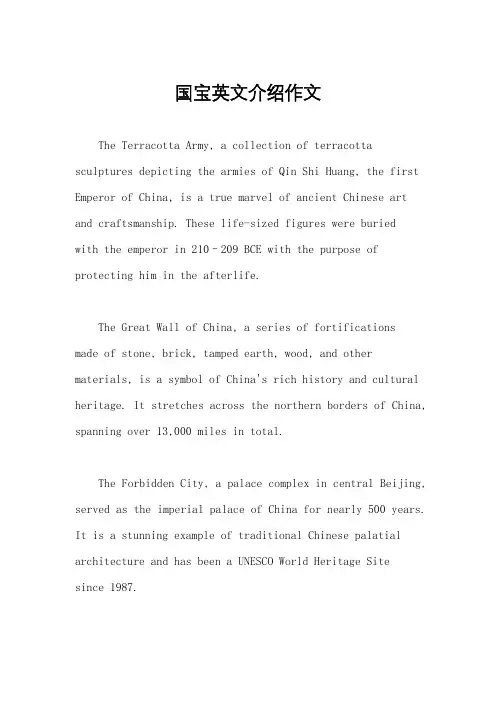
国宝英文介绍作文The Terracotta Army, a collection of terracotta sculptures depicting the armies of Qin Shi Huang, the first Emperor of China, is a true marvel of ancient Chinese art and craftsmanship. These life-sized figures were buriedwith the emperor in 210–209 BCE with the purpose of protecting him in the afterlife.The Great Wall of China, a series of fortifications made of stone, brick, tamped earth, wood, and other materials, is a symbol of China's rich history and cultural heritage. It stretches across the northern borders of China, spanning over 13,000 miles in total.The Forbidden City, a palace complex in central Beijing, served as the imperial palace of China for nearly 500 years. It is a stunning example of traditional Chinese palatial architecture and has been a UNESCO World Heritage Sitesince 1987.The Temple of Heaven, an imperial complex of religious buildings situated in the southeastern part of central Beijing, is a masterpiece of ancient Chinese architectural design. It was used by the emperors of the Ming and Qing dynasties for annual ceremonies of prayer to Heaven for good harvest.The Summer Palace, a vast ensemble of lakes, gardens, and palaces in Beijing, is a testament to the harmonious blending of nature and architecture in traditional Chinese garden design. It has been a popular retreat for emperors seeking respite from the summer heat.The Peking Man Site at Zhoukoudian, a cave system in Beijing, is an important archaeological site that has yielded many significant discoveries, including the remains of Homo erectus. It provides valuable insights into the early human history and evolution in East Asia.The Mogao Caves, a network of Buddhist cave temples near the town of Dunhuang in Gansu province, is renownedfor its exquisite murals and statues. These caves are atreasure trove of ancient Buddhist art and have been designated as a UNESCO World Heritage Site.The Mausoleum of the First Qin Emperor, located in Lintong District, Shaanxi province, is the burial site of Emperor Qin Shi Huang and is famous for the terracotta army. It is a monumental architectural achievement and atestament to the power and grandeur of the Qin Dynasty.The Mount Tai, a sacred mountain in Shandong province,is a place of great cultural and historical significance in Chinese civilization. It has been a place of worship for at least 3,000 years and has inspired countless poets, scholars, and emperors throughout Chinese history.The Classical Gardens of Suzhou, a series of gardens in Suzhou city, Jiangsu province, are masterpieces ofclassical Chinese garden design. These gardens are renowned for their exquisite beauty and have been recognized as a UNESCO World Heritage Site.。
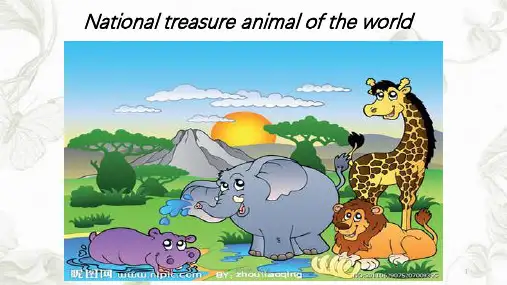
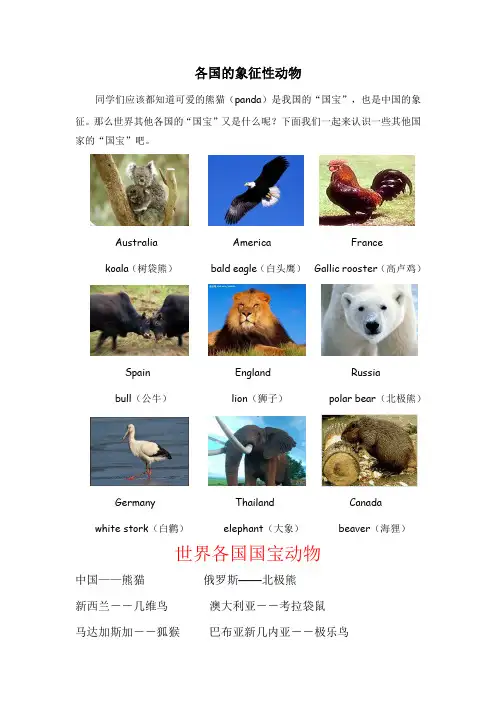
各国的象征性动物
同学们应该都知道可爱的熊猫(panda)是我国的“国宝”,也是中国的象征。
那么世界其他各国的“国宝”又是什么呢?下面我们一起来认识一些其他国家的“国宝”吧。
Australia America France
koala(树袋熊)bald eagle(白头鹰)Gallic rooster(高卢鸡)
Spain England Russia
bull(公牛)lion(狮子)polar bear(北极熊)
Germany Thailand Canada white stork(白鹳)elephant(大象)beaver(海狸)
世界各国国宝动物
中国——熊猫俄罗斯——北极熊
新西兰--几维鸟澳大利亚--考拉袋鼠
马达加斯加--狐猴巴布亚新几内亚--极乐鸟
美国——秃鹰英国——知更鸟
德国——灰熊瑞士——圣贝尔纳狗
西班牙——公牛加拿大——海狸
尼泊尔——独角犀牛泰国——大象
挪威——驼鹿日本——朱鹮
南非有5大国宝动物——狮子,豹子,大象,水牛,犀牛。
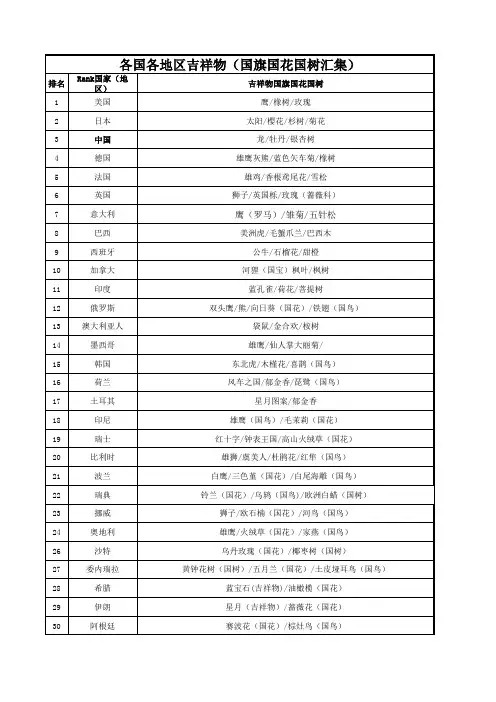
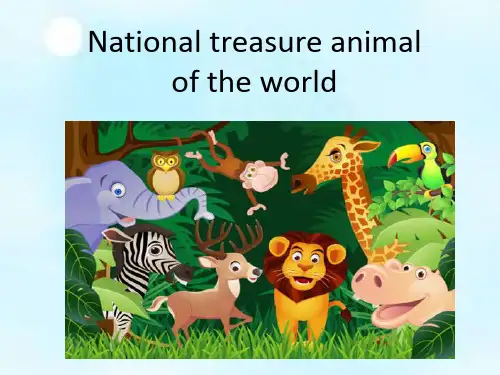
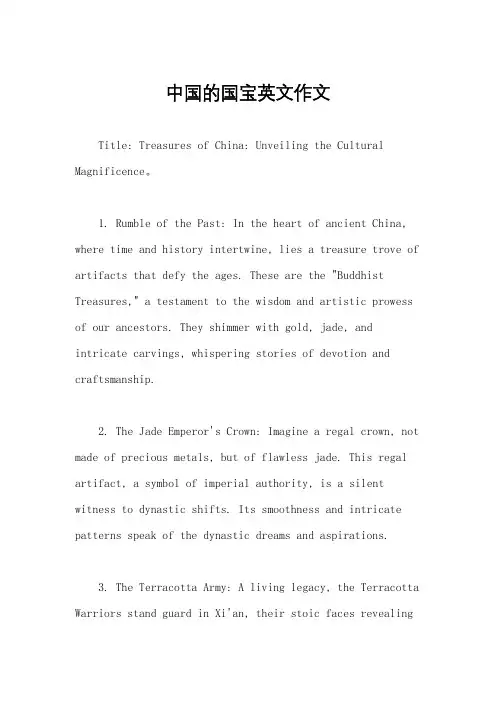
中国的国宝英文作文Title: Treasures of China: Unveiling the Cultural Magnificence。
1. Rumble of the Past: In the heart of ancient China, where time and history intertwine, lies a treasure trove of artifacts that defy the ages. These are the "Buddhist Treasures," a testament to the wisdom and artistic prowess of our ancestors. They shimmer with gold, jade, andintricate carvings, whispering stories of devotion and craftsmanship.2. The Jade Emperor's Crown: Imagine a regal crown, not made of precious metals, but of flawless jade. This regal artifact, a symbol of imperial authority, is a silent witness to dynastic shifts. Its smoothness and intricate patterns speak of the dynastic dreams and aspirations.3. The Terracotta Army: A living legacy, the Terracotta Warriors stand guard in Xi'an, their stoic faces revealingthe might of a vanished empire. Each clay figure, uniqueand meticulously crafted, is a reminder of the grandeur of the Qin Dynasty and the human spirit's resilience.4. The Great Wall of China: Stretching across the horizon, the Great Wall is not just a defense, but a symbol of human ingenuity. Its bricks, each one a testament to the labor of countless hands, tell tales of perseverance andthe connection between the land and its people.5. The Forbidden City: A palace of dreams, theForbidden City is a living museum, where the whispers of emperors still echo. Its grandeur and intricate design, a fusion of Eastern aesthetics and royal grandeur, invite usto ponder the power and rituals that once filled its halls.6. The Silk Road: A trade route that spanned continents, the Silk Road was more than a network of roads. It was a bridge between cultures, where silk, spices, and ideas were exchanged. Its legacy, like a thread in the tapestry of global history, still weaves its magic.In conclusion, these treasures are not just physical remnants, but the soul of China. They embody the spirit of our nation, a living testament to our rich cultural heritage. Each one is a story waiting to be discovered, a beacon of our past, present, and future.。
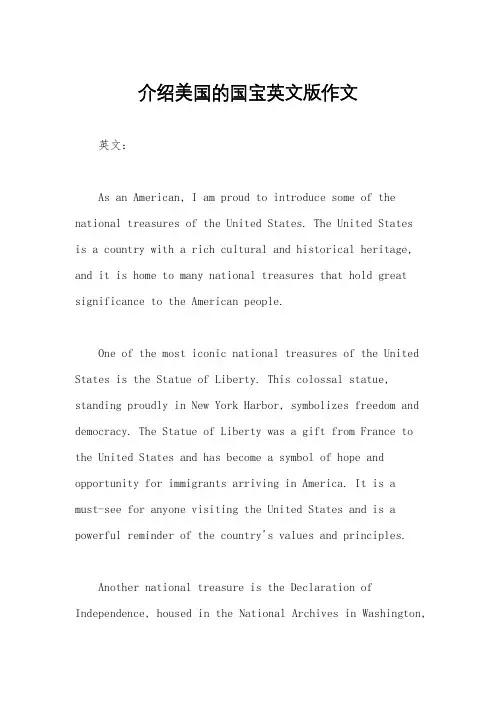
介绍美国的国宝英文版作文英文:As an American, I am proud to introduce some of the national treasures of the United States. The United Statesis a country with a rich cultural and historical heritage, and it is home to many national treasures that hold great significance to the American people.One of the most iconic national treasures of the United States is the Statue of Liberty. This colossal statue, standing proudly in New York Harbor, symbolizes freedom and democracy. The Statue of Liberty was a gift from France to the United States and has become a symbol of hope and opportunity for immigrants arriving in America. It is amust-see for anyone visiting the United States and is a powerful reminder of the country's values and principles.Another national treasure is the Declaration of Independence, housed in the National Archives in Washington,D.C. This historic document, signed in 1776, marked the birth of the United States as an independent nation. It is a testament to the courage and determination of the founding fathers who fought for the country's freedom. The Declaration of Independence is a powerful symbol of the country's commitment to liberty and equality.Moving on, the Grand Canyon is a natural wonder that is also considered a national treasure. This breathtaking canyon, located in Arizona, is a testament to the power of nature and the beauty of the American landscape. It is a popular destination for tourists and outdoor enthusiasts, offering stunning views and opportunities for hiking and adventure.In addition to these iconic national treasures, the United States is home to many other significant landmarks and cultural artifacts that hold great meaning for the American people. From the Liberty Bell in Philadelphia to the Lincoln Memorial in Washington, D.C., these national treasures serve as reminders of the country's history, values, and achievements.中文:作为一个美国人,我很自豪地介绍美国的一些国宝。
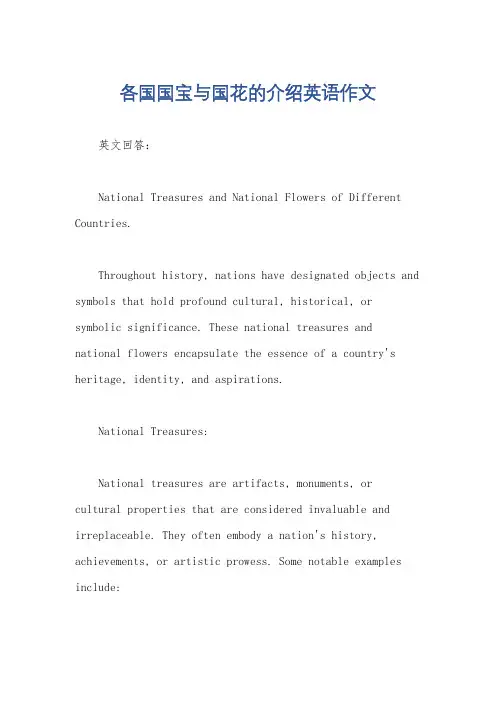
各国国宝与国花的介绍英语作文英文回答:National Treasures and National Flowers of Different Countries.Throughout history, nations have designated objects and symbols that hold profound cultural, historical, or symbolic significance. These national treasures andnational flowers encapsulate the essence of a country's heritage, identity, and aspirations.National Treasures:National treasures are artifacts, monuments, orcultural properties that are considered invaluable and irreplaceable. They often embody a nation's history, achievements, or artistic prowess. Some notable examples include:Great Wall of China (China): A colossal fortification dating back to the 7th century BC, spanning thousands of miles and serving as a testament to Chinese engineering and military prowess.Taj Mahal (India): An exquisite mausoleum built by Mughal emperor Shah Jahan in the 17th century as a tribute to his beloved wife. Its intricate architecture and lush gardens epitomize Mughal wealth and artistic refinement.Mona Lisa (France): Leonardo da Vinci's enigmatic masterpiece, renowned for its enigmatic smile and technical brilliance. It has become one of the most iconic and recognizable paintings in art history.Dead Sea Scrolls (Israel): A collection of ancient biblical texts discovered in the mid-20th century, providing invaluable insights into Jewish history and early Christianity.Anglo-Saxon Sutton Hoo Ship Burial (United Kingdom): A stunning collection of artifacts and a ship discovered inthe 7th century, shedding light on Anglo-Saxon culture and burial practices.National Flowers:National flowers are symbolic plants that embody anation's values, traditions, or natural beauty. They are often used in official ceremonies, decorations, and as a symbol of national pride. Some examples include:White Lotus (Vietnam): A symbol of purity, serenity, and spiritual enlightenment, deeply rooted in Vietnamese culture and Buddhism.Sakura Cherry Blossom (Japan): A symbol of spring, renewal, and beauty, celebrated in festivals and ceremonies throughout the country.Rose (England): A symbol of love, passion, and beauty, associated with the House of Tudor and the English monarchy.Maple Leaf (Canada): A symbol of strength, endurance,and resilience, featured prominently on the Canadian flag and coat of arms.Xanadu Tulip (Netherlands): A vibrant and colorful flower that symbolizes the Netherlands' role as a tulip-growing nation and is associated with the Dutch Golden Age.中文回答:各国国宝与国花介绍。
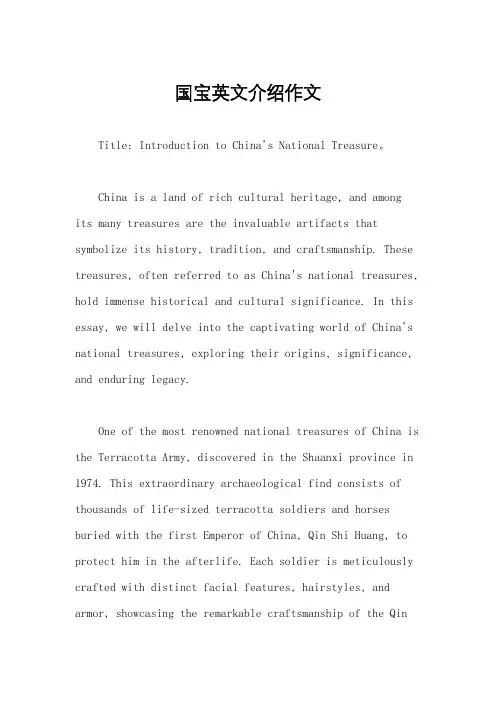
国宝英文介绍作文Title: Introduction to China's National Treasure。
China is a land of rich cultural heritage, and amongits many treasures are the invaluable artifacts that symbolize its history, tradition, and craftsmanship. These treasures, often referred to as China's national treasures, hold immense historical and cultural significance. In this essay, we will delve into the captivating world of China's national treasures, exploring their origins, significance, and enduring legacy.One of the most renowned national treasures of China is the Terracotta Army, discovered in the Shaanxi province in 1974. This extraordinary archaeological find consists of thousands of life-sized terracotta soldiers and horses buried with the first Emperor of China, Qin Shi Huang, to protect him in the afterlife. Each soldier is meticulously crafted with distinct facial features, hairstyles, and armor, showcasing the remarkable craftsmanship of the QinDynasty artisans. The Terracotta Army not only serves as a testament to ancient Chinese military prowess but also provides invaluable insights into the political and social structures of the time.Another iconic national treasure is the Great Wall of China, a marvel of ancient engineering and a symbol of Chinese resilience and ingenuity. Stretching over 13,000 miles across rugged terrain, the Great Wall stands as a monumental feat of defensive architecture, built over centuries to protect China from invasions by nomadic tribes. Its construction commenced as early as the 7th century BC and continued through successive dynasties, with each ruler adding their own section to strengthen the defenses. Today, the Great Wall remains a symbol of China's enduringstrength and unity, attracting millions of visitors from around the world.In addition to architectural marvels, China's national treasures also include exquisite works of art, such as the Dunhuang Mogao Grottoes. Located in Gansu province alongthe ancient Silk Road, the Mogao Grottoes comprise a vastcomplex of Buddhist cave temples adorned with intricate murals, sculptures, and manuscripts. These artistic masterpieces, created over a span of a thousand years,reflect the fusion of Buddhist, Indian, and Central Asian influences, making them a testament to China's cultural exchange and artistic innovation.Furthermore, China's national treasures encompass awide array of ancient artifacts, from bronze vessels of the Shang and Zhou dynasties to delicate porcelain of the Ming and Qing dynasties. Each artifact tells a story of China's past, reflecting the artistic achievements, technological advancements, and cultural exchanges of the respective eras. These treasures not only serve as reminders of China's glorious history but also inspire a sense of pride and reverence among the Chinese people.In conclusion, China's national treasures represent the epitome of its rich cultural heritage, spanning millenniaof history and encompassing a diverse range of artifacts, monuments, and artworks. From the majestic Terracotta Armyto the awe-inspiring Great Wall and the exquisite DunhuangMogao Grottoes, these treasures bear witness to China's enduring legacy of craftsmanship, innovation, and cultural exchange. As custodians of these national treasures, it is our collective responsibility to preserve and cherish them for future generations, ensuring that their legacy continues to inspire and enrich our lives.。
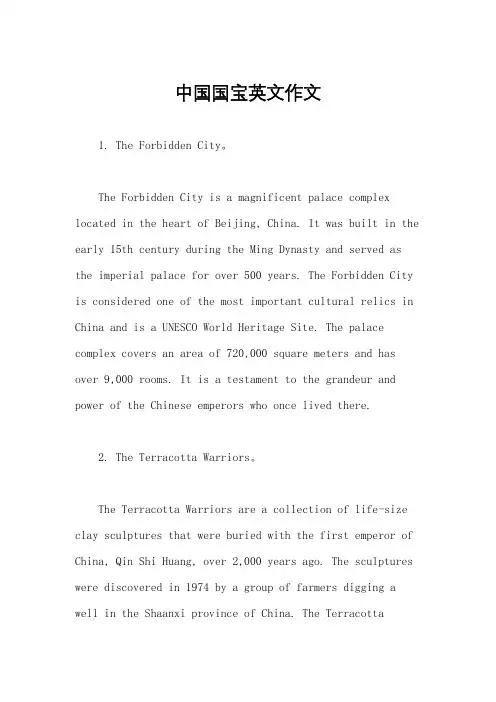
中国国宝英文作文1. The Forbidden City。
The Forbidden City is a magnificent palace complex located in the heart of Beijing, China. It was built in the early 15th century during the Ming Dynasty and served as the imperial palace for over 500 years. The Forbidden City is considered one of the most important cultural relics in China and is a UNESCO World Heritage Site. The palace complex covers an area of 720,000 square meters and has over 9,000 rooms. It is a testament to the grandeur and power of the Chinese emperors who once lived there.2. The Terracotta Warriors。
The Terracotta Warriors are a collection of life-size clay sculptures that were buried with the first emperor of China, Qin Shi Huang, over 2,000 years ago. The sculptures were discovered in 1974 by a group of farmers digging a well in the Shaanxi province of China. The TerracottaWarriors are considered one of the greatest archaeological finds of the 20th century and are a symbol of China's rich cultural heritage. The sculptures depict soldiers, horses, and chariots and are believed to have been created to protect the emperor in the afterlife.3. The Great Wall of China。
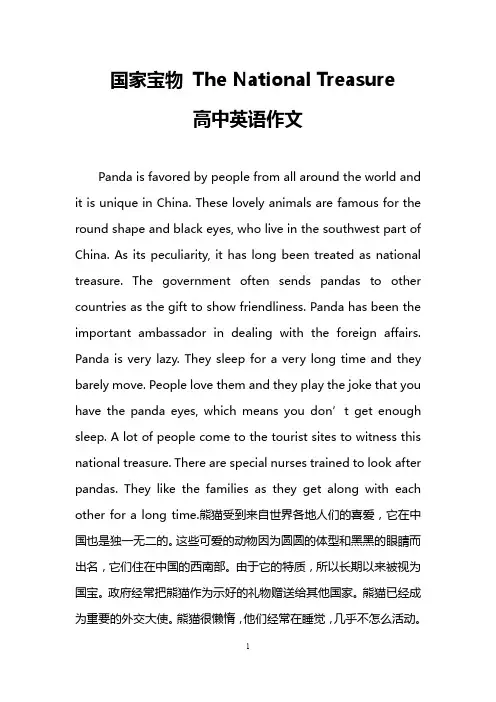
国家宝物The National Treasure高中英语作文Panda is favored by people from all around the world and it is unique in China. These lovely animals are famous for the round shape and black eyes, who live in the southwest part of China. As its peculiarity, it has long been treated as national treasure. The government often sends pandas to other countries as the gift to show friendliness. Panda has been the important ambassador in dealing with the foreign affairs. Panda is very lazy. They sleep for a very long time and they barely move. People love them and they play the joke that you have the panda eyes, which means you don’t get enough sleep. A lot of people come to the tourist sites to witness this national treasure. There are special nurses trained to look after pandas. They like the families as they get along with each other for a long time.熊猫受到来自世界各地人们的喜爱,它在中国也是独一无二的。
国家宝物TheNationalTreasure英语作文国家宝物The National Treasure英语作文(精选20篇)国家宝物The National Treasure英语作文篇1Panda is favored by people from all around the world and it is unique in China As its peculiarity, it has long been treated as national treasure Panda has been the important ambassador in dealing with the foreign affairs They sleep for a very long time and they barely move A lot of people come to the tourist sites to witness this national treasure They like the families as they get along with each other for a long time.国家宝物The National Treasure英语作文篇2Pandas are rare animals in the world. They are national treasures of China. I like them very much.Pandas have black and white fur. They have dark eye circles around their eyes. Pandas like eating bamboo.And their bodies are fat.I often go to the zoo nearby to see pandas. I really enjoy watching cute pandas.国家宝物The National Treasure英语作文篇3Nanshan bamboo to the two giant pandas. Dad took me to see the giant panda.Giant pandas at the top of the hill, it will take the cable car to the past. We sat and a cable car up slowly, the pieces of bamboo in my body, I feel like I'm going to fly to heaven.Finally, we came to the giant pandas live. A: wow! Really has two white and fat panda.A is the sun in the sun, a stretch and a moment with a belly roll a few, very cute! The other one in the bamboo leaves, it while eating, also watching visitors, like said in my mind: "wow! Thesepeople dress is gorgeous! But we have only black and white color, if we can put on colorful clothes, that would be great!The giant panda is really interesting!国家宝物The National Treasure英语作文篇4The movie Kung Fu Panda looks like a kung-fu novel, in accordance with Chinese-style plot development. It is mainly about a fat panda's dream to bee a master of kung fu, and a coincidental let that dream bee a reality. Of course, Po (the panda) has gone through a series of twists and turns before reaching success.Impressed me most is a series of Chinese elements in the film, from the name we can know it is the film for Chinese - kung fu and panda. It is not just kung fu and panda. There are other Chinese elements in it. Such as the Chinese mandarin, the Chinese house, acupuncture, erhu, calligraphy and so on.Of course, that it can bee North America's box office leader and could attract foreigners are not only those causes. In this film, everywhere is full of philosophical dialogues. The turtle said "There are no accidents." Po's father, described in the mysterious soup, said "To make something special, you just have to believe it's special." That I like the most is "Yesterday is history, tomorrow is a mystery, but today is a gift. That is why it's called the present." It tells us to make good use of today.2008 is a Chinese year, Kung Fu Panda also allow international friends to learn more about Chinese culture and connotation.国家宝物The National Treasure英语作文篇5The giant panda is a special product of our country. It is a lovely small animal and very pleasing. The giant panda can be described as a perfect vegetarian. Giant pandas like to eatbamboo shoots, but they also eat bamboo, roots and flowers. The cute face, plus a black and white sweater, looks very lovely. Pandas are the most popular animals for girls.The giant panda is not active in high places, generally living on land, contrary to squirrels. The giant panda is solitary and likes to live alone and often has no fixed residence because of changing seasons. In the spring, it usually stays in the high mountain bamboo forest of more than 3000 meters. In the summer, we move to the shady slopes of bamboo shoots. Autumn moves to the slopes of xiangyang to prepare for the winter.Giant pandas are fat and stout. The head is round, the ear is small, the kiss is short and the tail is short. The white face was black with a black kiss and eye ring, and a black strap stretched from the shoulders to the entire front, like a black and white coat.The giant panda is about 1.5 meters long and weighs 160kg, and its black-and-white body hair is characteristic of pandas. Giant pandas eat more than 10 to 12 hours a day and eat 15 to 20 kilograms of food a day. People have cut off most of their bamboo forests for agricultural development, and there are now bamboo places that can only feed two to 36 giant pandas, and the giant panda is listed on the national list of protected animals.There are fewer and fewer pandas now. I hope people will love it more and protect it.国家宝物The National Treasure英语作文篇6In this full of vitality in nature, there are many lovely animals, but my favorite also belongs to our national treasure of China -- the giant panda.The giant panda is very cute and fluffy it, black and white fur particularly conspicuous, round head, with a pair of black ears,has been standing, as if in listen to what. He has a pair of black eyes. Eyeball always transfer guru, outside a layer of hair and eyes, seems to be deliberately dyed deep black, if you don't watch carefully, thought he was wearing a dark glasses!The giant panda is our national treasure of China, it is not only valuable, and the number is very few and far between, in China, the number of pandas but also more than one thousand, how many countries and even pay a high price to buy, but didn't get it.The panda is a mammal, is usually a viviparous two, while the red panda is more lovely, his life, it is golden, the pandas is made of bamboo is the staple food.We should protect small animals, love the nature, the giant panda has now very few, if people don't care, the giant panda like the dinosaur extinction, sooner or later, so we should cherish our pandas let us together to protect giant pandas.国家宝物The National Treasure英语作文篇7I like many animals, but my favorite is the giant panda. Giant pandas are rare animals in China, their hometown in sichuan province.Giant panda looks interesting, chubby, plump and cute. Its head and body are white, only the rim of the eye, ear, and the shoulder is dark brown. Especially that a pair of black rim of the eye, long in white face, like wearing a pair of sunglasses, plus the clumsiness and go up and look in all directions, appear very lovely.Pandas in zoos, through training the breeder uncles and aunts, also many performance! Such as drilling circle, upright, upside down, or cartwheel and pushing the car. I most like to see the giant panda says. It huddled in her chubby body, like a bigball rolling, funny, very fun. Pandas don't like the cat that greediness eat fish meat, don't eat the delicious fruit, like a monkey pandas like eating bamboo leaves and shoots.I love pandas, it can be seen everywhere in my little world. My pencil-box. The head of a bed, desk, plastered with pictures of giant pandas. In art class, if the teacher asked the paint free proposition, I often draw a panda. These, may all is because I am too fond of pandas!国家宝物The National Treasure英语作文篇8Pandas are lovely animals .Most of them live in the deep forests of sichuan province in China .They have white fur ,though their shoulders ,legs ,ears and eyes are black .Pandas are usually very heavy ,some of them can be about 1.5 metres tall and weigh about 100 kilongrams .However ,pandas are very agile ,they can climd trees as easily as some other creatures do.Pandas have big ,sharp teeth and live live mainly on bamboo leaves.Every day each grown –up pandas eats about 15-30 kilograms of bamboo leaves and they usually spend 10-12 hours eating .Pandas also have spare–time hobbies .T ow of their hobbies are climbing trees and sleeping .Sadly ,there are not many pandas left in the world because some people keep cutting down trees ,and bad hunters are trying to kill them for money .The Chinese government is doing its best to protect pandas from being harmed or killed .国家宝物The National Treasure英语作文篇9Pandas are one of the most precious animals in the world.They are white and black.They look fat and funny.Theyeat bamboo.People all over the world like them very much. There used to be many pandas in China long ago. As the balance of nature was destroyed and the weather was getting warmer andwarmer, pandas became less. But at present, the number of pandas is increasing year by year.There are now so many pandas that some are being sent to other countries so that people there can enjoy them.The biggest nature park for panda in China is in Sichuan.Scientists hope that one day they will have enough pandas to be set free and let them live in the wild again.国家宝物The National Treasure英语作文篇10In the winter, I play with my father and mother went to the panda base.An enter a door, every tree hung with a panda doll, quite the atmosphere of the panda base, in a short time, we went to the panda screens, there is very big, with little panda, it's because of have to do, I went to a near-end, saw inside film about a panda's on.I learned that the giant panda belongs to the spine mammalia animal door a carnivore, giant pandas have said the bear, length 120 cm, tail about 18 cm long, about 45 cm long arm, leg about 75 cm long. Weight about 90 kg, is my two times.Film said above, the giant panda called "bamboo forest recluse", yes! Every panda each have each activity area but smaller scale, so less activity, thereby reducing the energy cost, with the usual TV introduction "giant pandas at low nutrition, low energy of bamboo, to reduce the scope of activities and activity level, more rest in special activities of energy saving way". Don't look at the panda fat, total love uphill climb. Just two or three hours, they are not eat bamboo and drink, is to eat, drink foot, climb up the tall wooden bridge, have a good night's sleep, as if just like to sleep on the wooden bridge, haven't seen sleeping on the ground, and safe and comfortable, so probably originatedfrom carnivorous ancestors instinct!Finished watching the movie, we went to the youth of the giant panda "villa", intently I use my mother's mobile phone took nearly five minutes short, they are a little afraid at first, but soon adapted to. Let me it is a pity that they are so lazy, in addition to holding a bamboo chew is lay asleep, turn over a new sleeping position to continue is rare "big", rarely up to walk, let alone play, really wish them up with horn. Ha ha, no wonder they grow so fat!To walk, we saw two little panda, a sleeping, a play, the last play naughty baby panda should only wake her brother. This is what a lovely baby pandas, naughty!How time flies, soon in the afternoon, time to go home, I reluctantly left the panda base.I look back, water, green bamboo, man and nature is how harmonious ah.国家宝物The National Treasure英语作文篇11Pandas are my favourite animals.In fact,all the people like pands as well.Pandas living in the wild can live for 20 years while the pandas that live in the zoos can have a life of more thqn 30 years.Pandas are really lovely.They can not only climb trees but also swim.However,the number of pandas is decreasing sharply.It is said that there are only 1000 pandas remaining in the world at present.It is sad news for all of us.Therefore,we are supposed to take measures to protect pandas in order to prevent them from dying out.国家宝物The National Treasure英语作文篇12Panda is the cutest animal in the world. It is so lovely. It has black eyes and round body. once I went to the zoo to watch pandas. They were eating bamboo all the time, and sometimesthey played in the tree. I love them so much, so I watch them quietly and not to disturb them. It is not right to throw food to them.国家宝物The National Treasure英语作文篇13Little friends, have you ever seen a panda? Today, I first went to possessing long island adit day panda enclosure to see the pandas.The panda is very cute, its head round, like a big ball. Its ears semicircle, like my stationery semicircle ruler; It has small eyes, like two black marbles, around the rim of the eye black, called "panda eye", when the adults stay up or fight fist on the eyes, will become "panda eye", so know the history of the "panda eye"? It is triangular nose, like a small dumplings, small mouth, short limbs, body fat, start to gently across, it has nine pieces of black, is a nose, two eyes, two ears, four legs.I see a panda in the panda enclosure three only. A just lounging in sleep, when it saw us come in, when he sat up and looked at us, idly seem seems to have played with us hello, lazily lie down again to continue its dream, is so cute! Straight to sit down on the ground, as a very honest with relish eating bamboo, like we usually eat sugar cane, it eat can be sweet sweet, is really enjoy! And the other doing? Look, it comfortably leaned against the wood in bamboo, eating side carefree, side as if he were with us said: "you see me how nice!"I like the lovely panda. Little friends, do you also want to go to see the pandas?国家宝物The National Treasure英语作文篇14There are many animals in the world, my favorite is the giant panda. Panda is a rare animals, is also a national treasure, their hometown in sichuan province.The panda looks very interesting, it's chubby, sleek, looks very cute, its head and body are white, only the rim of the eye, ears, hands and feet are brown. It that a pair of black rim of the eye in particular, long in white face, like wearing a pair of dark glasses, coupled with the heavy action and walk up a pendulum is a west east, a twist twist, also constantly look in all directions, it seems to be very cute.Summer day, our whole family to the zoo, "visit" panda "Sir", specially saw feeding uncles and aunts are training them some interesting performance! Such as turning somersault, upright, upside down and push the car and so on. What I enjoy most is it flips, it put the fat body huddled up, like a big ball, rolling, funny, very funny. Pandas don't like the cat would eat fish and also not how to eat fresh fruit, it likes to eat bamboo and bamboo shoots, eat up to head a slanting, slanted eyes, arms holding, mouth like saying: "delicious!" It can concentrate in eating! What do you call it, it also ignored us, just enjoy myself, I have seen it so focused, deliberately to fight it, to throw to a banana to it. A: hi! This guy is lowered his head bowed their heads and big big stuttering with bamboo leaves, is really a not greedy little animals.Giant pandas are so cute, I like the giant panda.国家宝物The National Treasure英语作文篇15Hi,everyone! I ‘m Mike. Pandas are animals. Now, let me tell you sonething about the pandas.Ciant pandas are the national treasure of China. They are so cute that they are popular all over the world. Pandas are black and white and they like eating bamboo very much.Because they are heavy sometimes they look clumsy and funny.However,pandas are in great danger. Pandas do not have many babies in their lifetime and some babits even die ofillnesses. What worse, people keep cutting down the forest so pandas have less food to eat and fewer places to live in.In order to protect pandas, thegovernment should make some laws on pandas protection. As members of earth, we should love the nature and uild animals. I hope there uill be a lot more pandas in the future.国家宝物The National Treasure英语作文篇16Needless to say that pandas are not only a kind of rare animals of China but also the world, and all the people is undoubtedly crazy about them.These lovely and smart guys live in mountains, and its are fond of bamboo. Unfortunately, bamboo has been damaging recently, so it is more and more difficult for pandas to find food. What’s worse, its are in endangered.However, our country had set up a host of nature researches. Nevertheless, we still cannot help all of its because we don’t have enough money.Above all, I wish you, the kind teenagers come to join us. Only in this way can our planet be flooded with endless harmony and happiness.国家宝物The National Treasure英语作文篇17the giant panda is known as the national treasure of china. the panda was a kind of ordinary animal in china long ago. however, for some reasons, too many of them have been killed. so the number of them is falling quickly.at present people are taking an important measure to save pandas. people want to find a home for them, and recently, they have set up a nature park for them in sichuan province,which is called "pandas' home. "there pandas can enjoy their life happily. there is a bamboo forest near the pandas' home. so the pandascan find bamboos easily which they like to eat very much.国家宝物The National Treasure英语作文篇18The giant panda is the rarest member of the bear family and among the world’s most threatened animals. It is universally loved.Today, the giant panda's future remains uncertain. As China's economy continues rapidly developing, this bamboo-eating member of the bear family faces a number of threats. Its forest habitat, in the mountainous areas of southwest China, is increasingly fragmented by roads and railroads. Habitat loss continues to occur outside of protected areas, while poaching remains an ever-present threat.国家宝物The National Treasure英语作文篇19Giant pandas are unique to our country and are often used as a valuable gift to foreign heads of state. They all had bright black fur, two big "black eyes", with black hair on their backs, ears, hands and feet, and all the other places were white and beautiful!Giant panda grow fat, HanHanDe, clumsy, start to slow, is fat and docile, very cute, let people can't help that looks simple and honest honest love the animals.There are only over a thousand pandas in the world. They are already appeared on the earth millions of years ago, has experienced all sorts of climate change, environmental changes, is in the animal world is very old animals, we should protect them well.You might be wondering, "why are giant pandas so rare?" Let me tell you! For baby panda mother under a secondary seldom, most only one, and baby pandas born body thin and small, only about 100 grams, just like a little mouse, size of the baby panda is doomed it at a young age is not easy to live in the nature oflaw of the jungle!You should know a lot about pandas after listening to my introduction. Do you like pandas? If you like, protect them together, and protect their home - nature, so that these lovely little angels can live happily.国家宝物The National Treasure英语作文篇20I went to the panda base with my classmates last week. it was raining, but we were very happy.there were many pandas in the base, one was eating bamboo, another was sleeping, they were so enjoyable. i took a picture with this lovely pandas.When i back home, i wrote a report about pandas.i had a dream this night, a panda was in my dream, it was playing and smiling at me.。
【导语】想必有很多小伙伴会经常找一些英语相关的文章来看以加强英语的提升,整理了高中英语作文,快来看看吧!希望能帮助到你~更多相关讯息请关注!【篇一】国家的宝物 The National TreasurePanda is favored by people from all around the world and it is unique in China. These lovely animals are famous for the round shape and black eyes, who live in the southwest part of China. As its peculiarity, it has long been treated as national treasure. The government often sends pandas to other countries as the gift to show friendliness. Panda has been the important ambassador in dealing with the foreign affairs. Panda is very lazy. They sleep for a very long time and they barely move. People love them and they play the joke that you have the panda eyes, which means you don’t get enough sleep. A lot of people come to the tourist sites to witness this national treasure. There are special nurses trained to look after pandas. They like the families as they get along with each other for a long time.熊猫受到来自世界各地人们的喜爱,它在中国也是独一无二的。